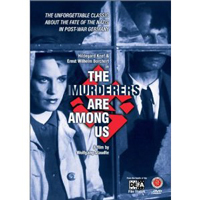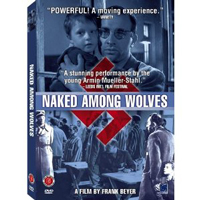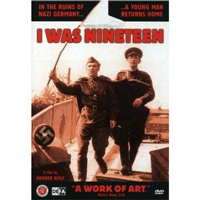
 |
|
|
|
First Run Features has released a number of fascinating films originally produced in East Germany after the end of WW2. Entertainments produced by the state-run film studio and school DEFA were often tailored to fit political objectives formulated in harmony with the aims of the Soviet bloc. Western Germany and West Berlin were slow to re-start film activities, as the Allied countries preferred to distribute American and English product. DEFA's output directly addressed the trauma of defeat and post-Nazi politics in the new Germany -- even in the rubble of the big cities, it was feared that the National Socialists might make a comeback. The four features in DEFA's Anti-Nazi Classics disc set span twenty years. The first was a hit in both East and West Berlin, while the later films take a more polarized view of the Soviet Union's former Allies. But in each case we see talented filmmakers trying to make human statements and not just propaganda. First Run's extras include text essays that explain the social and political context of the films. 
Although all of the titles in the set are now virtually unknown in the United States, The Murderers Are Among Us (Die Mörder sind unter uns (1946) received wide distribution in Europe as the first post-war German feature effort. Ex- Goebbels filmmaker Wolfgang Staudte somehow made the jump to the Soviet-controlled East German film industry, and took both directing and writing credit on this impressive, guardedly optimistic portrait of Germany's regeneration from the ashes. Young Dr. Mertens (Ernst Wilhelm Borchert) drifts in and out of an alcoholic funk, disillusioned by his war experience and no longer believing in the future. Concentration camp survivor Susanne Wallner (Hildegard Knef, later to become an international star) shares a ruined apartment with Martens and motivates him to return to work. They witness the sad end of an old optician (Robert Forsch), who dies before news arrives that his son has survived and is on his way home. Mertens runs into his old commanding officer Brueckner (Arno Paulsen), now a prosperous family man. The unhappy doctor determines to avenge the hundreds of Polish civilians that Brueckner ordered shot two Christmases earlier. The Murderers Are Among Us draws many of its visuals from classic German expressionist filmmaking, with the Berliners eking out a living in ruins crisscrossed by raw beams of light. Mertens and Suzanne live in a wrecked apartment where old X-ray plates replace missing panes of glass. The only inviting spaces are a sleazy nightclub/pickup bar and Brueckner's handsomely restored house. When the murderous Mertens drifts into a Christmas celebration in a long coat and hat, he looks very much like Jack the Ripper from Pabst's Pandora's Box of seventeen years before. Later typed as rigid Nordic type, Hildegard Knef is the soul of trust and affection here, and provides balance for Mertens' existential hopelessness. Borchert makes a great-looking defeated German, and reminds us a bit of Tommy Lee Jones. The movie adds up as a tragic but positive story of social uplift, delivering the stern message that justice will not be done until decent Germans inform on Nazi rats like Brueckner. An impressive montage effect shows the ex-Nazi restrained in a shrinking matte, which turns into the bars of a prison. The Murderers Are Among Us was released before the Iron Curtain slammed down. DEFA's output would soon include movies openly accusing the American government of colluding with Fascist elements before, during and after the war, and working to undermine the "harmonious people's republic." Director Kurt Maetzig's 1950 Council of the Gods (Der rat der Götter) is an exposé about an international oil cartel's involvement in the Nazi firm that manufactured the death gas used in extermination camps. This DEFA set picks up again in 1961, with a return to a less controversial subject, Hitler's loathsome scheme to justify the 1939 attack on Poland that officially began WW2. 
1961's The Gleiwitz Case (Der Fall Gleiwitz) sees director Gerhard Klein using a rigorously controlled, austere filming style to portray the ruthlessly efficient Nazi perpetrators of the infamous pre-dawn raid. With Hitler's armies already massed for the attack, agents impersonated Polish commandos and attacked a radio station in Gleiwitz, near the Polish border. They transmitted a fake radio challenge to Germany boasting of their outrageous attack. Before leaving they shot and killed an innocent Polish prisoner dressed to resemble a commando who didn't make it. The emphasis is on the cold-blooded cruelty of the operation: the methodical way the raiders recruited and orders were issued. The fake commandos are Germans fluent in Polish; they each swear to never divulge a word about the grotesque deception, with the penalty that all the commandos and their extended families will be liquidated should anyone talk. The way the hapless Polish prisoner is selected is also detailed; he never has a clue what lies in store for him, or that his captors refer to him as 'canned goods'. Director Klein keeps his angles precise and the movements of the raiders sharp; the Nazi discipline seems almost admirable. The DVD notes inform us that the East German cultural authorities didn't like the movie. They resented the absence of a 'mouthpiece' character to openly condemn the Nazi raid. The Communist overseers also complained that the daring raiders inadvertently come off as heroes, defying human decency to achieve their mission. The Gleiwitz Case feels like a humorless, ruthless foretaste of the sadistic super-spy subgenre to come. 
1963's Naked Among Wolves (Nackt unter Wölfen) must have been a challenge for its director Frank Beyer, as it is a brutal concentration camp story that manages a happy ending of sorts. The place is Buchenwald in 1945, when anticipation of the approaching Americans threw the camp's normal operation into disarray. The Nazi guards secretly plan their exit strategies, which include murdering all the prisoners. The helpless internees slow down their daily routines in the hope of staying alive. Into this mess, a prisoner smuggles a very small child, a Polish Jew. The politics become sticky when a friendly guard curries favor with the inmates with an eye to saving himself when the Allies arrive. He promises to help keep the boy a secret, but also considers turning in the ringleaders to the camp commandant. Naked Among Wolves presents plenty of noble behavior under stress. The real life story actually had a good ending: the real rescued boy appears in a newsreel amended to First Run's disc. Among the nervy inmates conspiring to fool the guards is a very young Armin Mueller-Stahl, and the large cast becomes almost as endearing as the cast of a POW film like The Great Escape. But the East German view of Buchenwald is selective at best. The movie exaggerates the armed rebellion at the story's end, and leaves us with the good feeling that all will be better after the liberation. In reality the Soviets soon reopened Buchenwald, to house Nazi war criminals as well as dissenters to Soviet rule. Some prisoners freed by the U.S. Army found themselves again behind the same barbed wire. This fact doesn't mesh well with the film's final jubilant tone of freedom for all. Just the same, Naked Among Wolves is free of stereotypes and generates quite a bit of suspense. We get the idea that the prisoners successfully hid the little boy for several months, when they actually kept him for almost three years. 
The newest film in the collection is 1968's I Was Nineteen (Ich war neunzehn), director Konrad Wolf's semi-autobiographical account of the adventures of an inexperienced German-Russian Lieutenant, Gregor (Jaecki Schwarz). As the Russian Army closes in on Berlin Gregor is attached to a mobile propaganda squad that uses a loudspeaker to entreat German soldiers to surrender. The boy is stupefied when a general makes him the temporary commandant of the city of Bernau; his sergeant has to show him what to do. The rest of the story recounts the director's experiences during the last weeks of fighting. Gregor and a Russian comrade enter Spandau fortress to convince stubborn German holdouts to surrender. Some of the Nazi officers are convinced that the German and American armies have joined forces to fight the Russians. Things look bad when an SS commander gives the order to have the two Russian emissaries shot. Thanks to its interesting lead performance and a storyline that surprises at every step, I Was Nineteen is highly engaging. Gregor meets a disoriented German girl who doesn't understand why he speaks German but wears a Russian uniform. A red flag set out by a 'comrade' Mayor shows signs of having been a Nazi flag with the swastika ripped off. One episode suddenly changes to newsreel footage of a German concentration camp guard explaining how he helped murder 13 thousand Russians in only three months. Another involves a surprise German attack that uses stolen Russian tanks and equipment. Finally, at a farmhouse, Gregor and his friends receive hundreds of surrendering Germans, who are then fired upon by passing SS troops. Although the movie has the feeling of true events, it is obvious that its aim is to reinforce the idea that Germans need their Russians liberators and should consider them friends. The film's depiction of the Russian army contradicts the confirmed record of awful barbarity against Germans: indiscriminate looting, raping and killing. The German soldiers Gregor entices to surrender were taken to mass labor camps, many of them for years. The Russian victors in this movie are altogether gentle and humane types. The General, for instance, brings a number of concentration camp prisoners to his dining table, and the officers serve them. One shocked liberated prisoner is made the mayor of a village. They just drop him off and he tells the first man he meets, "I'm the mayor now." The movie ends on a hopeful note. 1 The four Anti-Nazi Classics don't advertise themselves as East German productions, so viewers may be surprised when a Polish prisoner in Naked Among Wolves suddenly delivers a blatantly pro-Soviet speech. We may react negatively to some of the political messages here, as well as some of the historical distortions. We're told that our government didn't dictate the content of our own war movies, yet much of what came out of Hollywood in the Cold War served as de facto enlistment boosters. First Run Features' DVD of Anti-Nazi Classics repackages four previously released discs. All are in German with English subtitles. From 2002, The Murderers Are Among Us looks like a PAL disc that has been converted to NTSC in a way that introduces chatter-frames on scenes with fast movement. From 2006, The Gleiwitz Case is a sharp and exacting transfer, the best-looking title in the package. Previously released in 2005, Naked Among Wolves has been given an enhanced widescreen encoding for its original 2.35 Aspect Ratio. First Run released I Was Nineteen in 2007. Its transfer looks very good but seems slightly odd presented at 1:33 for such a new film (1968). Although no scenes seem particularly crowded, artwork storyboards in the extras menu show that the designers were planning for a wider frame. 2 All of the discs come with production notes and text bios for key actors and personnel; some have East German newsreels, a short featurette and an art gallery. No trailers are included.
On a scale of Excellent, Good, Fair, and Poor,
Anti-Nazi Classics rates:
Footnotes:
1. The hero of this movie seems to have a lot in common with an editor friend of mine, who got himself into the Army when barely eighteen years old, and lived through the Battle of the Bulge. With his feet all but frozen, some superior officer put him in charge of an entire French railway depot. He could barely walk, couldn't speak French but found the liberated French railroaders cooperative and friendly!
2. I could very well be wrong, as I know nothing about the Aspect Ratio standardization of Eastern bloc films, and reliable information on these pictures is difficult to come by in English.
Reviews on the Savant main site have additional credits information and are often updated and annotated with reader input and graphics. Also, don't forget the 2010 Savant Wish List. T'was Ever Thus.
Review Staff | About DVD Talk | Newsletter Subscribe | Join DVD Talk Forum |
| ||||||||||||||||||